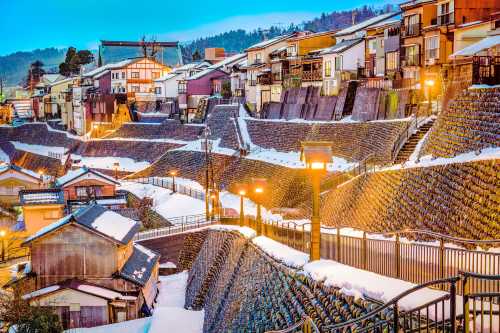Popular Trip Moments
The weekend routine of Toyama people is at [Zouquren] A good place for family strolls and market | Walking in Takaoka to Find Memories of "Doraemon" | 🚶♀️One-day tour to Toyama City, Japan's happy town | 📍Relaxation and souvenir shopping space by Iwase Port〔Iwase Canal Hall〕 | Toyama City Folk Museum [Toyama Castle], walk into the historical corridor in the castle 🏯📜 | Indulge in Toyama's Hearty Black Ramen at [Gattsuri! Ebisu] | The Natural Beauty of Japan's Mountains: Etchu-Toyama [Inotani Station] | A space where art and design come together 🎨 A journey to sharpen your sensibilities at the Toyama Prefectural Museum of Art | A fantastic dance dancing in the wind 🎐 The world of "Owara Bon Festival" encountered in the streets of Yao | A relaxing time at the national treasure, Zuiryuji Temple ✨ A tranquil trip to Toyama and Takaoka | A relaxing castle town where history and nature coexist in harmony 🌸 A quiet moment at Toyama Castle Ruins Park | A soothing oasis of water and greenery in Toyama 🌿 Spending some quiet time at Fugan Canal Kansui Park | View of Toyama Kansui Park | Starbucks in Toyama and eating ekiben on the Shinkansen to Hikone and Kyoto Tower~! | Euro Cafe et vous (Evou) Boulevard High Tea (Thailand High Tea) | The Most Comfortable Stay in Toyama: Toyoko INN Toyama Station South Exit | Midway stop at Toyama City before reaching Tateyama Kurobe | 🚋 A new experience for ground walking, Toyama Ichiba Nedetsu Bus Ticket. | Toyama Castle Park, a green space in the city | Toyama Castle: A Fusion of History and Modernity | 📖 A wonderful time where reading and architecture meet〔Toyama City Library Main Building〕 | 🍔 Exotic station in Toyama Electric Railway Station: Japanese and Korean exclusive Lotteria Lotte | ⛩️ Prayer path, pilgrimage to Sanmosha Shrine in Toyama Hie Shrine | Affordable Thick-Cut Pork Cutlet Fried to Perfection at [Toyama Tonkinton Shokudo] | A Tranquil Energy Spot in the City Center: Toyama Hie Shrine | The Beauty of the City: Toyama Glass Art Museum | Toyama Prefectural Museum – Free Art, Rooftop Playgrounds & Design Delights | 🌊🚉【Toyama - Roadside Station Amaharashi】 | 😎 Why Toyama Deserves More Than a Day | Toyama's must-try specialty: Black Ramen at Menya Iroha CiC Store
Recommended Attractions at Popular Destinations
Attraction near Bangkok | Attraction near Manila | Attraction near Tokyo | Attraction near Taipei | Attraction near Hong Kong | Attraction near Seoul | Attraction near Kuala Lumpur | Attraction near Los Angeles | Attraction near Shanghai | Attraction near New York | Attraction near Shenzhen | Attraction near Osaka | Attraction near Singapore | Attraction near London | Attraction near Guangzhou | Attraction near San Francisco | Attraction near Beijing | Attraction near Macau | Attraction near Bali | Attraction near Jakarta | Attraction near Paris | Attraction near Ho Chi Minh City | Attraction near Istanbul | Attraction near Phuket | Attraction near Chicago | Attraction near Seattle | Attraction near Toronto | Attraction near Orlando | Attraction near Cebu | Attraction near Chiang Mai
Popular Attractions
Shanghai Tower | Renwei Temple | Jingshan Park | Macao Open Top Bus | Lushan National Park | The Ancient City | Yuanmingyuan Park | War Remnants Museum | SHIBUYA SKY | Shanghai Zoo | Mercedes-Benz Arena | Maokong Gondola | Ning Xia Helan Mountain National Forest Park | Guinness Storehouse | The Sanctuary of Truth | Riverfront Park Splash Pad | Nanjing Presidential Palace | Donglin Academy | Sports Monster Theme Park | Jinjiang Action Park | Alvethorpe Park Baseball Fields | Wolfsschlucht | Bells Rapids Park Lookout | Linderhof Golf | Kota Seven wonders | Stadium five-Shuhada neighborhood | Confraternita di San Giuseppe e della Buona Morte | Chiesa di San Giovanni dei Battuti | La Seu d'Urgell Cathedral | Plaza Acentamiento humano santa Cruz Zona A
Popular Restaurants in Toyama
Izakaya Dai | Daishogun Ekimae | Daishogunoizumi | Toyama Hakobune | Cafe in the Park | Gomangoku, Honten | Cave Yunoki | Rico Monte | Yakiniku House Daishogun Sakuragicho | Sushi Eihanayagi | SYMPOSIUM | Sushiei | Starbucks Coffee - Toyama Kansui Park | Ana Crowne Plaza Hotel Toyama Astral Sky Bar | Sushidama, Toyama Station | DoubleTree by Hilton Toyama | BACCHUS | La BOMBANCE Kansuikoen | Shiroebiteitoyama | Toyamazushi Toyama Airport | Robatayaki Hyottoko | DRAGON RED RIVER Toyamaekimaeten | Marutakaya | CAFE CONTRAIL | Sushi Gekijyo Tottotoyareya | Kitokitohagiwara | Sobaizakaya Keyakitei | Kusunoki | Fukuya | KAIMARE
Popular Ranked Lists
Popular Must-Visit Restaurants in Taipei | Popular Must-Visit Restaurants in Frankfurt | Top 4 Best Things to Do in Wenling | Popular Luxury Hotels Near Quantock Hills | Popular Luxury Hotels Near Cape Finisterre | Top 3 Best Things to Do in Fuding | Popular Luxury Hotels Near Green Mountains | Popular Luxury Hotels Near Costa del Maresme | Popular Best Things to Do in Langfang | Popular Luxury Hotels Near Banks Peninsula | Popular Best Things to Do in Daqing | Top 5 Best Things to Do in Suqian | Popular Luxury Hotels in Tegernsee Lake | Popular Luxury Hotels Near Val di Fassa | Popular Luxury Hotels Near Upper Palatine Forest | Popular Best Things to Do in Luanping | Popular Luxury Hotels Near Somme Bay | Popular Best Things to Do in Linhai | Popular Luxury Hotels Near Harz | Popular Luxury Hotels Near Eifel | Popular Luxury Hotels in Kranj | Popular Luxury Hotels Near Elimnii | Popular Must-Visit Restaurants in Tokyo | Popular Luxury Hotels Near Pocono Mountains | Popular Must-Visit Restaurants in Singapore | Popular Must-Visit Restaurants in Koh Samui | Top 3 Best Things to Do in Dezhou | Popular Must-Visit Restaurants in Munich | Top 5 Best Things to Do in Songpan | Popular Must-Visit Restaurants in Yangzhou
Payment Methods
Our Partners
Copyright © 2025 Trip.com Travel Singapore Pte. Ltd. All rights reserved
Site Operator: Trip.com Travel Singapore Pte. Ltd.
Site Operator: Trip.com Travel Singapore Pte. Ltd.























